14 AI Tools For Stock Market
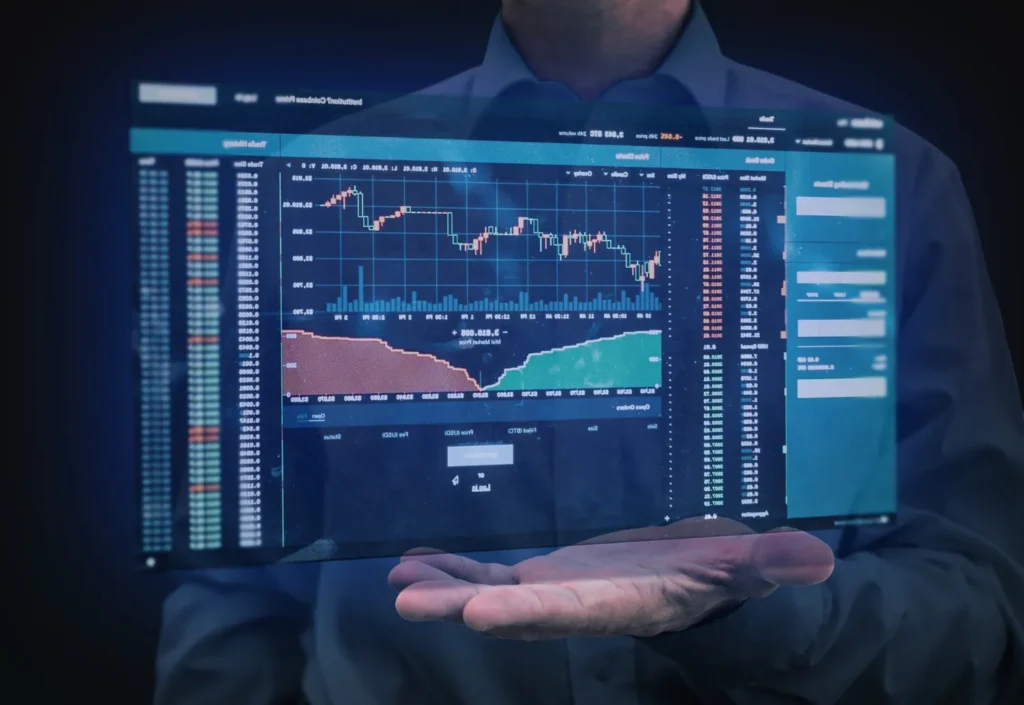
The stock market has long been a game of information and intuition. But what if there was a way to utilize the power of AI to gain an edge? AI tools are changing the world of finance, offering investors a new set of analytical capabilities to keep up with the constantly shifting market environment. This expanding market, expected to be worth a staggering $407 billion by 2027, is fueled by AI’s ability to sift through mountains of financial data, identify hidden patterns and trends, and ultimately revolutionize the way we approach stock selection and portfolio management.
In this blog, we’ll look into the AI tools for the stock market, examining how these intelligent systems are helping investors to make more informed decisions and potentially achieve greater returns.
What are Benefits of Using Stock Market?
1. Accuracy Boost: AI algorithms learn from past data to predict future market trends more accurately. This helps in making smarter trading choices and earning better profits.
2. Speedy Decisions: AI algorithms can quickly analyze vast amounts of data and make decisions faster that humans. This is particularly useful in fast-paced markets where split-second decisions matter.
3. Consistent Performance: Unlike humans, AI algorithms aren’t influenced by emotions like fear or greed. They stick to their programmed strategies, reducing the chance of making impulsive decisions that can lead to losses.
4. Diversification Opportunity: AI can help in creating portfolios with a mix of different stocks, reducing the risk of relying too heavily on one investment. This diversification can make the overall trading strategy safer.
14 AI Tools For Stock Market
1. Alpaca

Alpaca offers commission-free trading and provides an AI-powered platform that supports algorithmic trading. It allows users to backtest their strategies on historical data and execute trades programmatically. Alpaca’s APIs are straightforward, making it easier for developers to integrate their trading bots or strategies. It also provides paper trading, so users can test their strategies without risking real money.
HOW TO USE –
- Sign up on the Alpaca website and create an account.
- Explore the Alpaca dashboard to familiarize yourself with its features.
- Access the API documentation to understand how to connect your trading algorithms.
- Use their paper trading feature to test your strategies without risking real money.
- Once satisfied, switch to live trading to execute your strategies in the real market.
FEATURES –
– Commission-free trading for stocks and ETFs.
– API access for creating and testing trading algorithms.
– Real-time and historical market data for analysis.
– Paper trading to test strategies without using real money.
PRICE –
$10 per month
2. QuantConnect
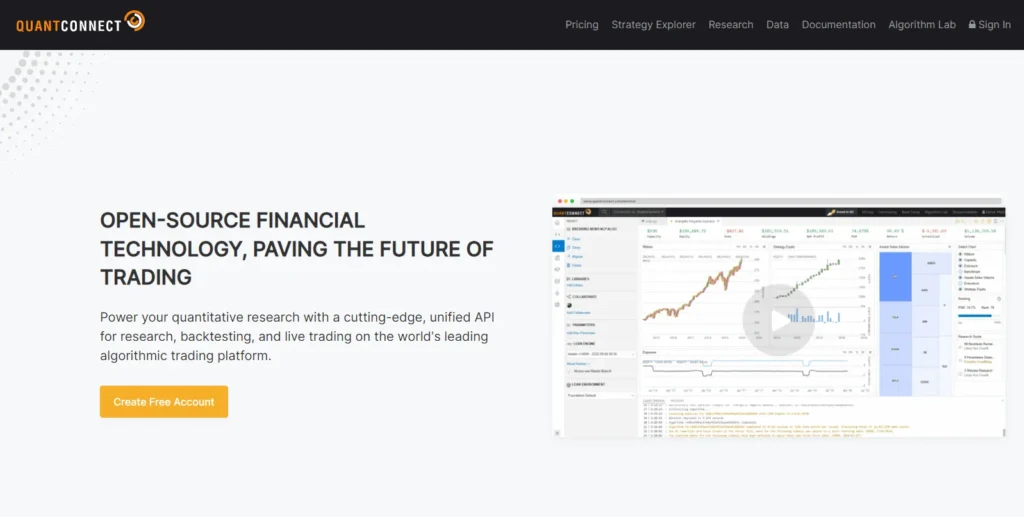
QuantConnect is an open-source algorithmic trading platform that supports multiple programming languages like Python and C#. It offers extensive historical data for backtesting and a cloud-based IDE for strategy development. QuantConnect’s Lean algorithm framework allows users to design, backtest, and deploy trading strategies in a streamlined environment. The platform’s community-driven approach also helps users learn from shared projects and research.
HOW TO USE –
- Sign up on the QuantConnect website and create an account.
- Start a new project in the cloud-based IDE.
- Write your trading algorithm using supported programming languages like Python.
- Use the backtesting feature to test your algorithm with historical data.
- Analyze the results and adjust your algorithm as needed.
- Deploy your algorithm for live trading when you are ready.
FEATURES –
– Supports multiple programming languages like Python and C#.
– Cloud-based integrated development environment (IDE) for algorithm development.
– Extensive historical data for backtesting trading strategies.
– Community sharing of projects and research for collaborative learning.
PRICE –
$600 Per year
3. Yahoo Finance
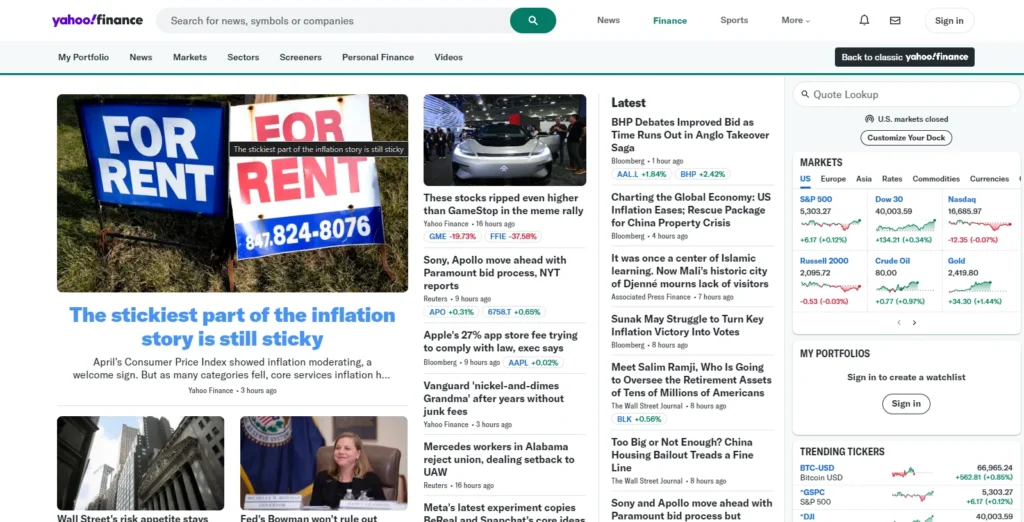
Yahoo Finance offers a wide array of tools for stock market analysis, including real-time data, news, and customizable charts. While it is not purely AI-based, its data feeds and stock screeners can be valuable for building your own AI models. The platform’s API enables users to extract financial data and integrate it into their own analytical tools and models for more in-depth analysis.
HOW TO USE –
- Go to the Yahoo Finance website and create an account if needed.
- Use the stock screener to filter stocks based on criteria like price, market cap, etc.
- Access real-time and historical data for detailed analysis.
- Use customizable charts to visualize stock performance.
- Follow relevant news and financial reports to stay updated.
- Integrate Yahoo Finance API into your AI models for deeper analysis.
FEATURES –
– Real-time stock market data and financial news.
– Customizable stock charts for detailed analysis.
– Stock screener with various filters to find potential investments.
– API access to integrate data into personal trading models.
PRICE –
14-day free trial and $34.99 per month
4. Alpaca Market Data
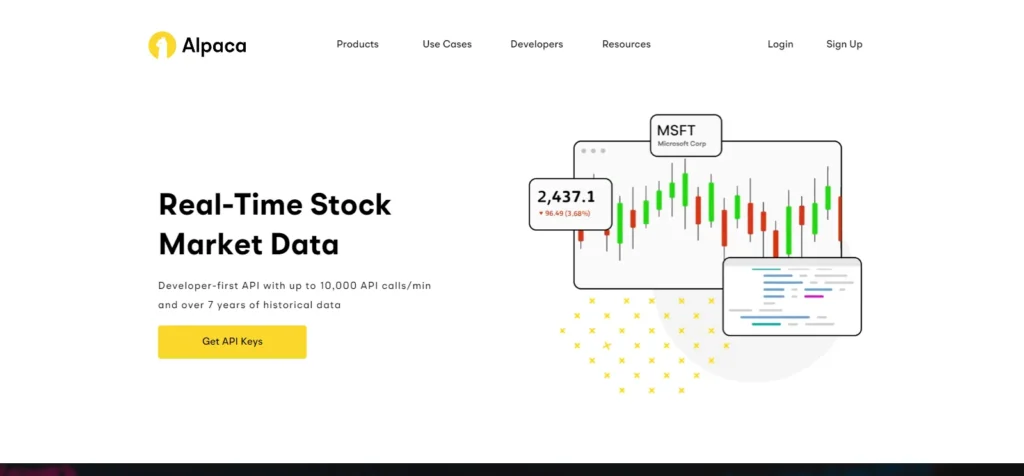
Alpaca Market Data provides free real-time and historical market data, making it a great resource for those developing AI trading strategies. It offers REST and WebSocket APIs that developers can use to access data efficiently. The platform’s comprehensive data includes trades, quotes, and bars, helping users build, backtest, and deploy effective trading algorithms.
HOW TO USE –
- Sign up for an Alpaca account and navigate to the Market Data section.
- Review the available APIs for accessing real-time and historical data.
- Use the provided API keys to authenticate your requests.
- Fetch the required data using REST or WebSocket APIs.
- Incorporate this data into your AI models for backtesting and prediction.
- Analyze the results and refine your strategies as needed.
FEATURES –
– Free real-time and historical market data.
– REST and WebSocket APIs for efficient data access.
– Comprehensive data including trades, quotes, and bars.
– Integration with AI models for backtesting and live trading.
PRICE –
Free
5. Finviz
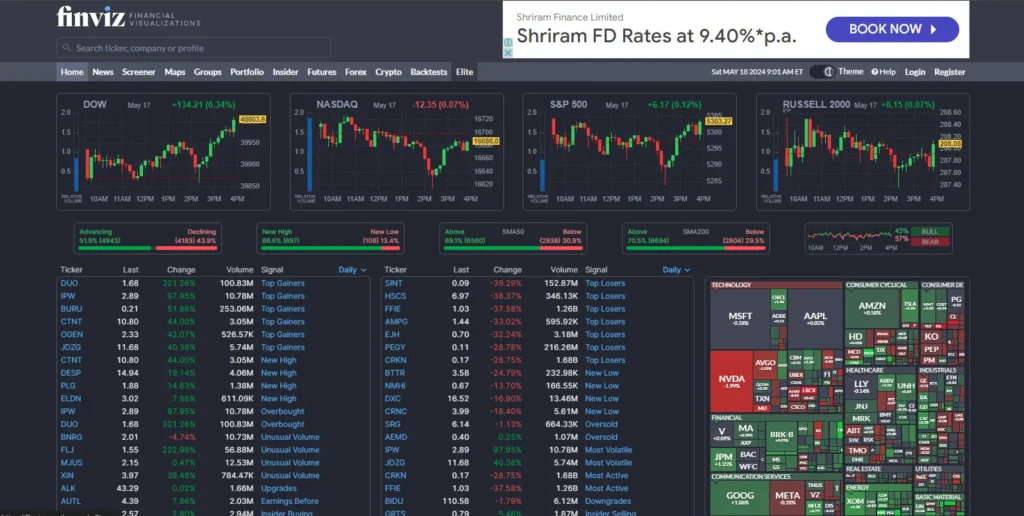
Finviz is a stock screener and research tool that offers a plethora of filters and visualizations for analyzing the stock market. While it doesn’t directly provide AI functionalities, it allows users to identify trends and patterns that can be used to develop AI models. Finviz Elite, the paid version, offers real-time data and advanced screening tools, but the free version is still very robust for initial analysis.
HOW TO USE –
- Visit the Finviz website and explore the free features.
- Use the stock screener to filter stocks based on your criteria.
- Visualize stock data with charts and heat maps.
- Analyze trends and patterns to identify potential trades.
- Save your screener settings for future use.
- Upgrade to Finviz Elite if you need advanced features like real-time data.
FEATURES –
– Stock screener with a wide range of filters.
– Visual tools like charts and heat maps for market analysis.
– Real-time quotes and financial news.
– Customizable screening settings to save and reuse filters.
PRICE –
$39.50 per month
6. TradeStation
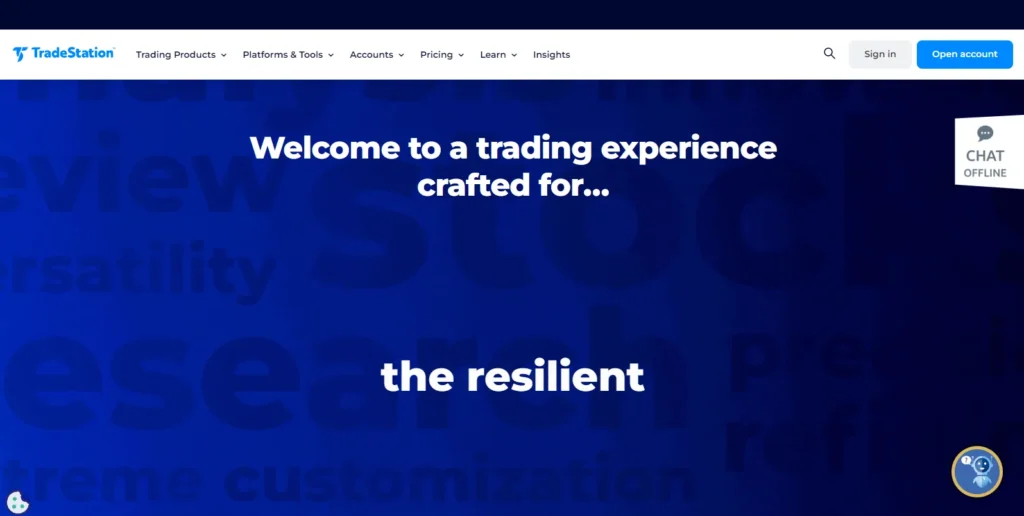
TradeStation offers a free trading simulator and a suite of analytical tools that can be used to develop and test AI-driven trading strategies. The platform supports EasyLanguage, a proprietary programming language for creating custom indicators and strategies. TradeStation also provides extensive historical data and a robust set of tools for backtesting and optimizing trading algorithms.
HOW TO USE –
- Sign up for a TradeStation account and download the trading platform.
- Explore the platform to understand its features and tools.
- Use EasyLanguage to create custom indicators and trading strategies.
- Backtest your strategies using historical data available on the platform.
- Analyze the performance of your strategies and make adjustments.
- Switch to live trading once you are confident in your strategy.
FEATURES –
– Trading simulator to practice strategies without risk.
– EasyLanguage programming for custom indicators and strategies.
– Extensive historical data for backtesting.
– Robust tools for optimizing and analyzing trading strategies.
PRICE –
$5 Commission per trade
7. Quandl
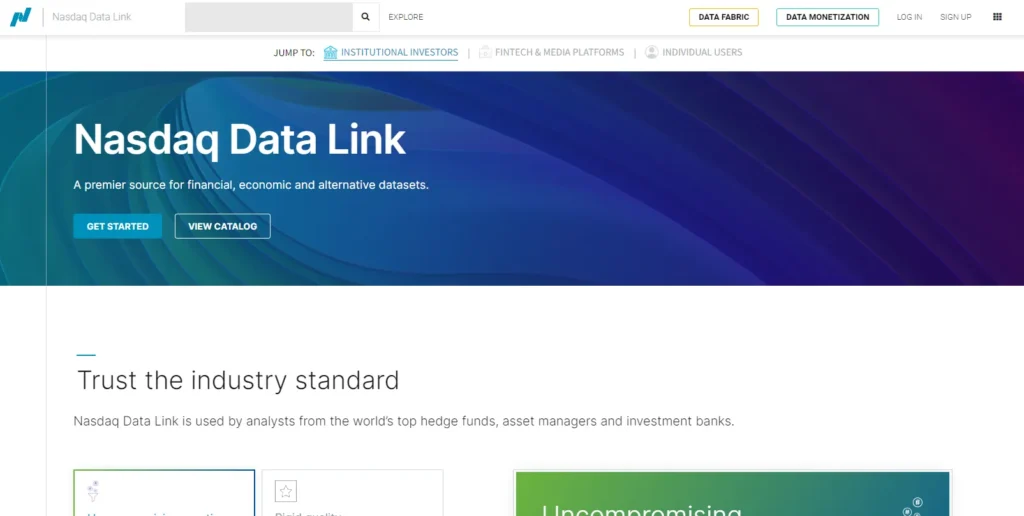
Quandl offers a vast collection of financial and economic data that can be used for developing AI models. It provides free access to some of its datasets, which include stock prices, futures, and foreign exchange rates. The data can be accessed via Quandl’s API, making it easy to integrate with AI algorithms for backtesting and predictive modeling.
HOW TO USE –
- Create a free account on Quandl’s website.
- Browse the available datasets and select the ones you need.
- Use the provided API keys to access the data.
- Integrate the data into your AI models for analysis.
- Use the data to backtest your trading strategies.
- Refine your models based on the backtesting results.
FEATURES –
– Vast collection of financial and economic datasets.
– Free access to select financial data.
– API access for integrating data into custom models.
– Data formats suitable for AI and machine learning analysis.
PRICE –
Free
8. TWS API by Interactive Brokers
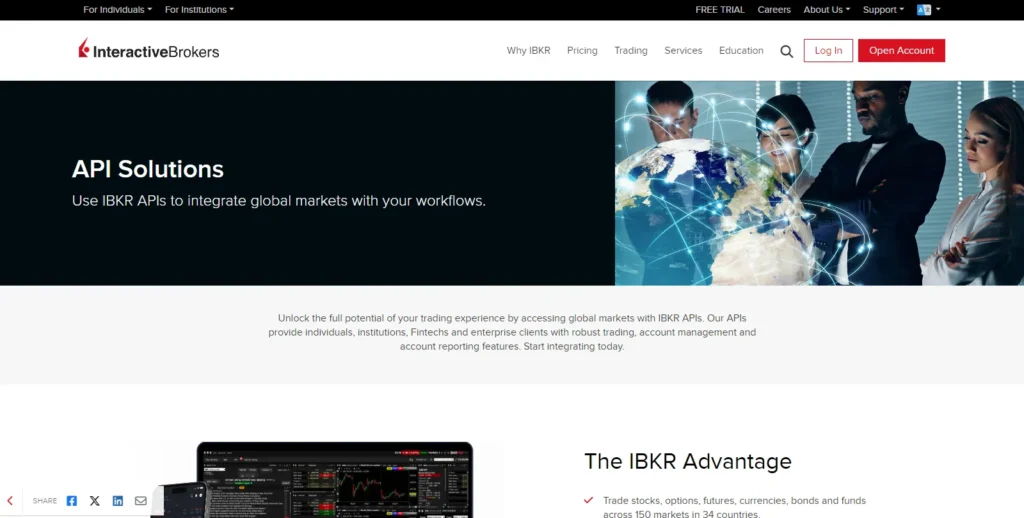
The Trader Workstation (TWS) API allows users to develop custom trading applications that can leverage AI for automated trading. Interactive Brokers provides extensive documentation and support for multiple programming languages, including Python, Java, and C++. The TWS API offers access to real-time market data, historical data, and order execution, facilitating the development of sophisticated trading strategies.
HOW TO USE –
- Create an account with Interactive Brokers and download Trader Workstation (TWS).
- Explore the TWS API documentation to understand how to use it.
- Choose a programming language (e.g., Python) and set up your development environment.
- Use the API to fetch real-time and historical market data.
- Develop your AI trading algorithm and test it using the data.
- Deploy your algorithm for live trading once you are confident in its performance.
FEATURES –
– Access to real-time and historical market data.
– Support for multiple programming languages like Python.
– Extensive API documentation for easy development.
– Capability to execute automated trading strategies.
PRICE –
Free
9. IEX Cloud
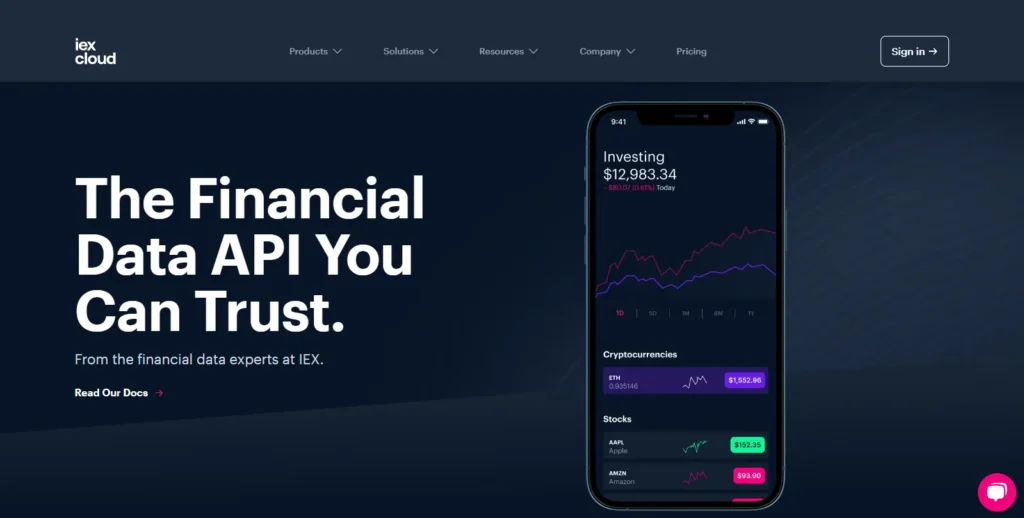
IEX Cloud provides financial data APIs that offer access to historical and real-time market data. The platform’s free tier gives users access to a variety of data points that can be used to develop and backtest AI trading models. IEX Cloud’s user-friendly API makes it easy to retrieve data and integrate it into custom applications for deeper market analysis.
HOW TO USE –
- Sign up for an IEX Cloud account.
- Get your API keys from the dashboard.
- Read the API documentation to understand the available endpoints.
- Use the API to fetch real-time and historical market data.
- Integrate the data into your AI models for analysis and backtesting.
- Adjust your trading strategies based on the insights gained from the data.
FEATURES –
– Access to real-time and historical financial data.
– User-friendly API for data retrieval.
– Variety of data points for comprehensive analysis.
– Free tier available for basic data access.
PRICE –
Free
10. Alpha Vantage
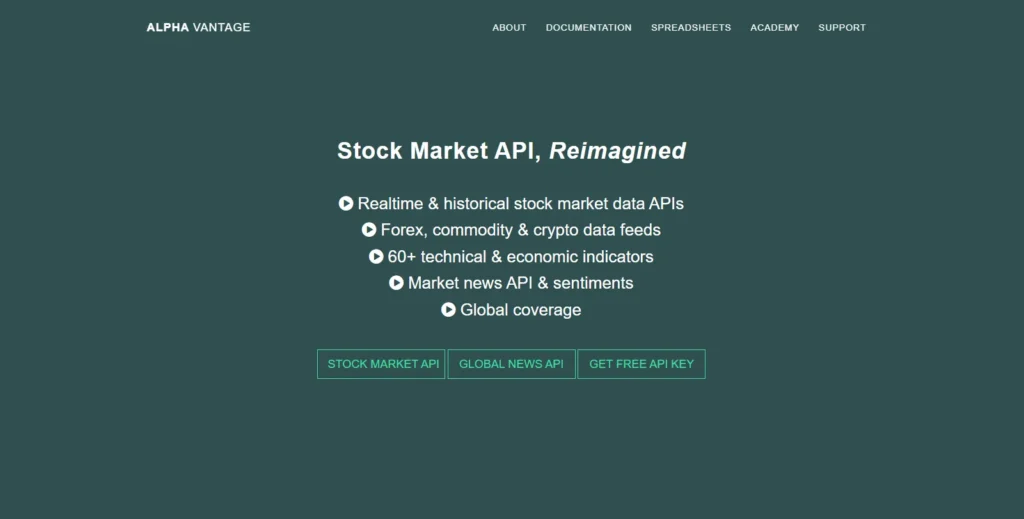
Alpha Vantage offers free APIs for financial market data, including real-time and historical stock prices, forex, and cryptocurrencies. The data can be accessed in various formats, making it suitable for developing AI trading models. Alpha Vantage also supports technical indicators, which can be integrated into AI algorithms to enhance predictive accuracy.
HOW TO USE –
- Sign up for a free account on the Alpha Vantage website.
- Obtain your API key from the account dashboard.
- Review the API documentation to understand the data available.
- Use the API to access real-time and historical stock data.
- Integrate the data into your AI trading models for analysis.
- Test your models and refine your strategies based on the results.
FEATURES –
– Free APIs for financial market data.
– Real-time and historical stock prices.
– Support for technical indicators.
– Data in various formats for easy integration.
PRICE –
Free
11. Kaggle

Kaggle is a platform for data science competitions and offers a wealth of financial datasets that can be used for developing AI trading models. Users can access pre-cleaned datasets, participate in challenges, and collaborate with other data scientists to refine their models. Kaggle’s community and resources make it an excellent place to learn and apply AI in stock market analysis.
HOW TO USE –
- Sign up for a Kaggle account and log in.
- Browse the Datasets section for financial data relevant to your analysis.
- Download the datasets or use Kaggle’s API to access them programmatically.
- Use the Kaggle Kernels (now called Notebooks) to build and test your AI models.
- Participate in competitions to improve your skills and get new ideas.
- Collaborate with the community to refine your models and strategies.
FEATURES –
– Large collection of financial datasets.
– Platform for building and testing AI models.
– Competitions to improve data science skills.
– Community collaboration for shared learning.
PRICE –
Free
Also Read: AI Tools and Software For Finance
12. Tiingo
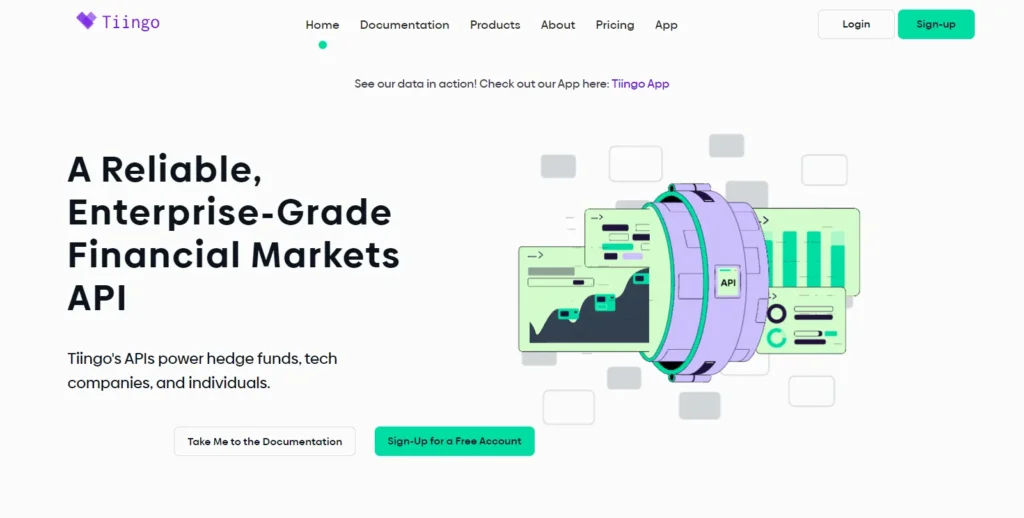
Tiingo provides a wide range of financial data, including stock prices, news, and fundamental data. Its API allows users to access real-time and historical data for developing and testing AI trading strategies. Tiingo’s data coverage and ease of use make it a popular choice for both novice and experienced developers looking to implement AI in their trading.
HOW TO USE –
- Sign up for a Tiingo account.
- Get your API key from the account dashboard.
- Review the API documentation to understand the data offerings.
- Use the API to access stock prices, news, and fundamental data.
- Integrate the data into your AI trading models for comprehensive analysis.
- Backtest your models and refine them based on performance insights.
FEATURES –
– Wide range of financial data, including stock prices and news.
– Real-time and historical data via API.
– Easy-to-use API for integration.
– Data suitable for AI-driven trading models.
PRICE – Free
13. Polygon.io
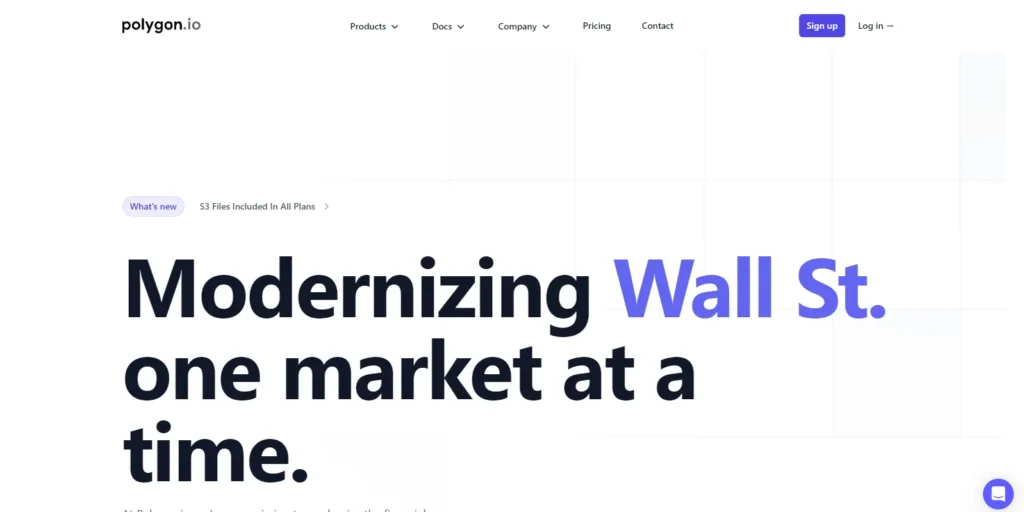
Polygon.io offers real-time and historical market data APIs that are useful for building AI-driven trading applications. The platform provides detailed data on stocks, forex, and cryptocurrencies, allowing for comprehensive market analysis. Polygon.io’s robust API documentation and support make it easy to integrate their data into custom trading algorithms.
HOW TO USE –
- Create a free account on the Polygon.io website.
- Obtain your API keys from the dashboard.
- Read the API documentation to understand the data endpoints.
- Use the API to fetch real-time and historical market data.
- Integrate the data into your AI models for analysis and backtesting.
- Test your strategies and refine them based on the insights gained.
FEATURES –
– Real-time and historical market data APIs.
– Detailed data on stocks, forex, and cryptocurrencies.
– Robust documentation and support.
– Suitable for building AI-driven trading applications.
PRICE –
$30 per month
14. Robinhood

Robinhood provides commission-free trading and access to a variety of financial instruments, including stocks, options, and cryptocurrencies. While primarily a trading platform, its API allows for the development of automated trading strategies using AI. Robinhood’s user-friendly interface and broad market access make it a suitable starting point for those looking to experiment with AI in trading.
HOW TO USE –
- Sign up for a Robinhood account and download the app.
- Explore the trading features and market data available on the platform.
- Use the Robinhood API to develop automated trading strategies.
- Test your strategies in a simulated environment if available.
- Once satisfied, execute your strategies in the live market.
- Monitor and adjust your strategies based on market performance.
FEATURES –
– Commission-free trading for various financial instruments.
– User-friendly interface for trading.
– API for developing automated trading strategies.
– Access to real-time market data.
PRICE –
Free
CONCLUSION
AI tools are a valuable addition to the investor’s toolkit, but not a replacement for sound judgment. Used wisely, they can enhance decision-making and navigate market complexities. As AI evolves, even more powerful tools will emerge, democratizing insights and reshaping the financial landscape. The future of stock analysis is entwined with AI, and its potential is undeniable.
FAQ’S
1. How does AI transform stock trading?
AI looks at large amounts of market data to find patterns and make quick trading decisions. This speed helps in fast-changing markets.
2. What are the main benefits of AI stock trading?
The main benefits are better accuracy, faster trades, consistent performance, good risk management, and the ability to see information that human traders might miss.
3. What are some limitations of relying on AI for trading?
Limitations include complexity, high costs, dependence on data, and not always understanding how the algorithms make decisions.
4. What types of traders can benefit most from AI technology?
AI trading is best for experienced traders who know the risks and have clear strategies that AI can help with.